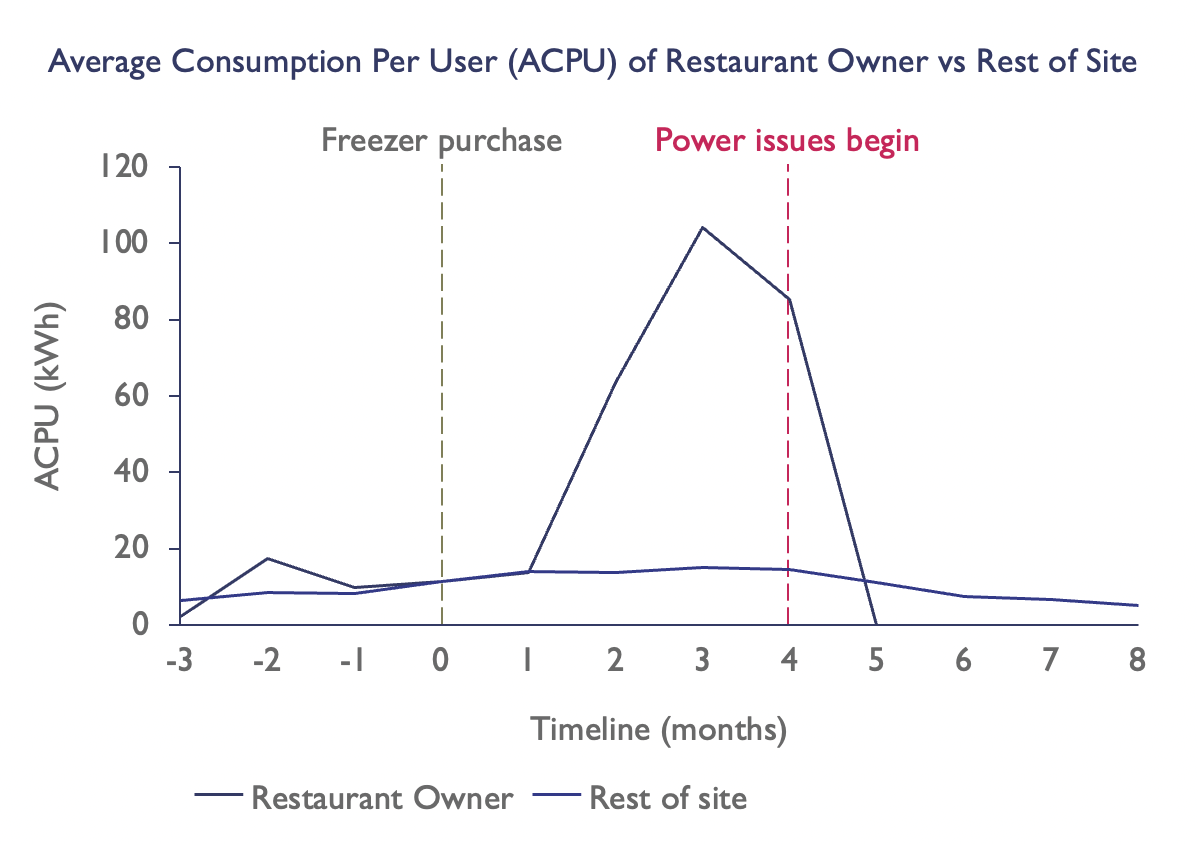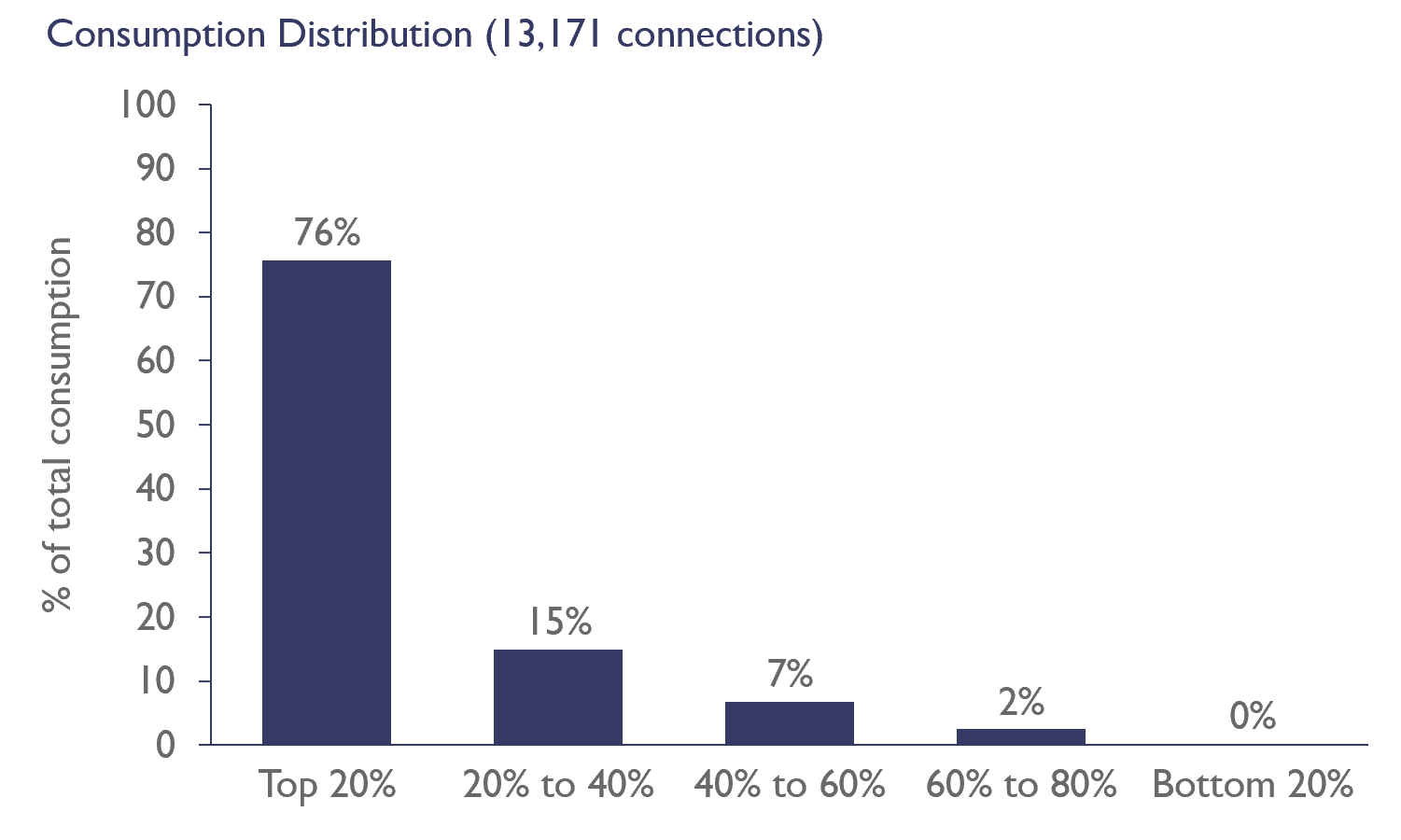Taking the electric brake off African enterprise

December 2021
In a small village in central Nigeria, a restaurant owner shakes his head in frustration. The power is out again, and he is about to disappoint his customers hoping for a cold drink. He unplugs his fridge and vows to shut up shop until he can afford a diesel generator.
This scene is a microcosm of what’s holding back businesses and entrepreneurs across Africa – unreliable power. Businesses lack access to reliable power from the centralized grid. Instead, they are forced to depend on expensive and polluting diesel generators—or adopt even more dramatic coping strategies like cutting back operations. However, distributed solar and batteries present a third option. This ‘third way’ is already the cheapest solution to delivering reliable power for over 60% of the countries in Africa.
The restaurant owner’s story is a real one. The graph below shows the underlying data behind it. He went from being one of village grid’s best customers, consuming eight times more electricity than average, to a zero-use customer after the grid started suffering power reliability issues.

A restaurant owner shows his zero tolerance for unreliable power. Source: CrossBoundary Innovation Lab
Energy companies cannot afford to lose commercial users like him. Commercial customers are critical for making the business of electrification profitable. For mini-grids in Africa, it’s typical for commercial customers make up 20% of users, but account for almost 80% of consumption, as the graph below shows.

Almost 80% of energy consumption on mini-grids comes from the top 20% of customers. Source: CrossBoundary Innovation Lab
On the main grid, the picture is even more extreme. In Kenya, 700 high-consuming commercial and industrial clients represent 0.01% of the national utility’s total customer base, but account for over 54% of total sales.
Like the shop owner, these commercial customers have zero-tolerance for unreliable power. A World Bank study found that for each additional hour of power outage per day, profits of commercial enterprises fall by 6.0%. In businesses with thin margins of 10-20%, even 2-4 hours of per day can put a business in the red and shut it down completely.
In African countries, this is the norm not the exception. As the chart below shows, customers in most countries in Sub-Saharan Africa do not receive reliable power through the main grid. On average across 34 countries, 25% of respondents got power less than half the time through their main grid connection.

Customers do not get reliable connection from the grid in most countries in Sub-Saharan Africa. Source: Afrobarometer Dispatch No. 334
The impact on businesses is severe. The World Bank found between 2006 and 2018, around 80% of sub-Saharan African firms suffered frequent electricity disruptions, typically six hours in length, imposing losses of around 8% of annual sales on average. Over the long-term, this has a crippling effect on a nation’s economy.

Power outages act as a handbrake to economic development. Source: IEA Africa Energy Outlook 2019
The chart by the International Energy Agency (IEA) above shows how unreliable electricity acts as a brake on economic activity. Above 100 hours of outages per year, the electric handbrake is firmly on. There is a cluster of countries ‘stuck in park’, all with outages above 100 hours per year and GDP/capita below $10k.
While governments grapple with the broader competitiveness consequences of unreliable power, businesses must rely on back-up fossil fuel generators. However, the service cost of diesel is high, ranging from $0.20/kWh to $0.60/kWh, double the retail price of grid-based energy which typically ranges from $0.10/kWh to $0.30/kWh.
Still, there is good news. In the last decade, a third option has emerged which is cheaper than diesel generators in every market, and has the potential to be cheaper than the main grid in over 60% of markets in Africa – distributed renewable energy (DRE) delivered via solar and battery storage. As of 2019, the power purchase agreement (PPA) prices achieved for solar with battery storage in the US had reached $0.20/kWh. The graph below shows the electricity supply costs for utilities in Africa. For 24 out of the 39 countries shown (over 60%), adding solar with storage at $0.20/kWh would deliver power at a lower levelized cost than their existing approach.

Over 60% of countries in sub-Saharan Africa have main-grid tariffs above $0.20/kWh. Source: Trimble et al 2016
Moreover, DRE systems are not just cheaper, they can increase reliability as well. Data from 66 solar and battery mini-grids across rural Africa shows that customers experience ‘normal’ stable supply, between 220V and 240V, 92% of the time.

Best-in-class mini-grids in Africa achieve ‘normal’ stable supply 92% of the time. Source: CrossBoundary Innovation Lab
Progressive frameworks can make DRE a partner to the main grid, improving reliability to support commercial enterprises
It is critical that governments and development partners recognize the potential of this ‘third way’ and help unlock its potential. Commercial customers cannot afford unreliability, and the business of electrification is not viable without them. The continent needs reliable power to support these commercial customers and drive economic growth.
DRE will play an increasingly large role in providing this power. It’s often a cheaper alternative than extending the main grid or using diesel back-up, and can improve reliability. This progression will move us from a centralized, government-only power system to a more decentralized grid of the future, a network balancing millions of nodes of generation, storage and consumption across utilities, public-private partnerships, and consumers. This future grid combines the best attributes of DRE and the traditional grid, increased resilience through multiple generation sources, and reduced storage needs through interconnectivity. Historically, governments and international donors have focused almost solely on increasing the number of people connected to power. They need to reframe incentives and regulatory frameworks to reward reliable power, not just connections. Accelerating the adoption of DRE is the fastest and least cost way to achieve this.
